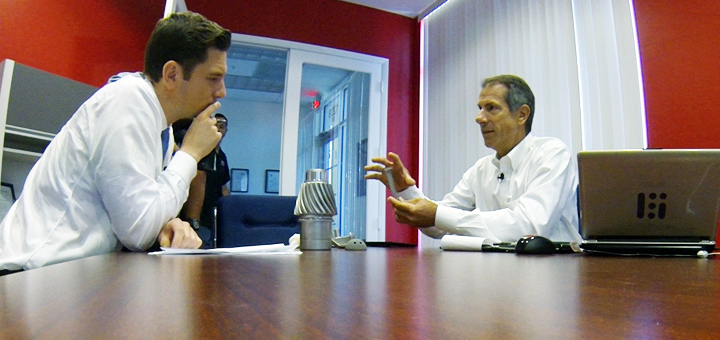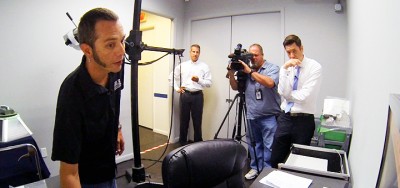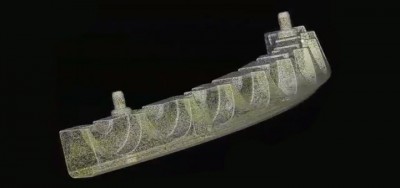
The Great 3D Revolution

Recently the social interwebs came alive with with video of a 25-year-old, Ray Ban-clad, hat bill-flipped Texan popping off rounds from a handgun at a local gun range. It wasn’t exciting. What was, is the fact that the gun he was using was made of all plastic and it was made with a 3D printer.
Cody Wilson shot once and killed twice that day. He killed the notion that 3D technology is only useful and available to professionals and the wealthy. He also killed any chance of the gun debate quietly dying off (as if that were ever going to happen anyway). After uploading the plans to his website, Defense Distributed, Wilson began a ‘Wiki-Weapon’ movement with what seems to be a new wave of technology. It was enough to sound the alarm for the State Department. They forced him to take his free plans offline, which he did. But that was after the plans were downloaded 100,000 times. It propelled the movement into all the dimly-lit corners of the globe. The new debate in gun control was born. Still, many Americans were left impressed, frightened and downright dumbfounded by this new technology.
The only problem is, there’s nothing new about it.
Behind quietly closed doors
Settled near a street in Stuart, Florida, you’ll find a bright network of buildings housing dozens of offices. Level 3 Inspection’s corporate offices are unassuming. Matter of fact, for such a bright exterior, the offices interior is quite dark. Engineers busily tap on keyboards, bending their bodies closer to glowing computer screens so their eyes can analyze cross-sections of 3D image scans. They’re looking at 3D models, exact replicas of a parts recently scanned by a 3D scanner in another room.
Wade Rigsby, the skinny, long side-burned 3D Scanning Manager looks more like a guy you’d find rolling down the street on a custom chopper or maybe participating in some adrenaline-laced event at the X-Games. Truth is, this guy is a genius.

Spitting facts and figures that seemingly would only make sense to a fellow engineer, Rigsby was bilingual enough to break it down for us laymen. He showed us how the scanner works, how he bends the light to get all kinds of data from a simple airline blade, which we later learn, is far from simple.
Bill Greene founded Level Three Inspection 12 years ago. He graduated in Metallurgical Engineering and Economics from the University of Arizona. He was top of his class. And if you have trouble pronouncing his engineering degree, you’d really struggle understanding what actually goes on inside Level 3 Inspection. It’s a lot of big words and complicated numbers, at least for this journalist. He really knows how 3D technology works, where it’s been and, more importantly, where it’s headed.
Greene’s company can take a small engine part from a jet (as in 737, F35, etc), scan it, study it and report back to the manufacturer with a list of things that could go wrong if that part is mass-produced. Greene says one company he’s worked with came to him with a troubled part that took them a year to diagnose. It still wasn’t right. The money and time was essentially wasted. The issue was later resolved by Level 3 Inspection in a matter of minutes with the company’s scanner and talented engineers. The preventable flaw saved the company millions of dollars, time, frustration and quite possibly, human lives.
One could argue that Level 3 Inspection’s work on the F-35 engine parts aids to ‘stop the bleeding’ as the military’s most expensive defense contract. That should put a smile on face of every tax-paying American. It’s your money. And a penny saved equates to multi-millions earned in this type of equation.
Greene says his company works on engine parts from the biggest manufacturers; Pratt-Whitney, General Electric, Rolls-Royce and more. The company also analyzes orthopedic implants like metal replacements, ball joints, hip components and more. Greene’s process could quite possibly assure that what’s implanted into your loved one in the future, works, and doesn’t ever need to come out.
Greene was even called to testify in the John Goodman trial in South Florida. Goodman is a wealthy polo tycoon who was found guilty in March 2012 of driving drunk two years earlier and smashing his Bentley into 23-year-old Scott Wilson’s Hyndai. Wilson’s car flipped into a canal. The engineering graduate drowned.

It was Greene who was hired by the Goodman’s defense team to prove that Goodman’s ankle monitoring device he wore during house arrest simply broke, and wasn’t tampered with as prosecutors alleged. Greene says he used his company’s inspection method to show the judge there was no possible way the device could have been tampered with. Greene’s scanner, using up to 4-million ‘touch points’ clearly showed the fractures and how they were made. Greene says traditional inspection uses up to 10,000.
The judge agreed and Goodman was found not-guilty of tampering. Goodman was recently given a retrial in the case stemming from other court testimony.
Where has 3D inspection been the whole time?
So why now? Why is 3D inspection, scanning and printing such a big deal? Maybe it’s because guns are such a big debate. Wilson poured gas on the already super-sized firethat is gun control with his plastic piece.
Greene thinks otherwise. He says it’s been around a long time. He also believes the ‘Normalcy Bias’, or a company’s fear of change, is the reason the technology hasn’t aided business on a much larger scale. Greene says the only way a new technology can take hold is with early adopters. He credits Pratt & Whitney as being one of those adopters by having their airline engine parts inspected with 3D technology.
 And with a grin, Greene says other competitors are noticing. He already knows 3D technology can save and enormous amount of time and money. He says it can also help a company get to market in record time. Greene feels his inspection techniques can aid, if not create, a new revolution. Companies can now have more of a role in their manufacturing process by using less time, spending less money and creating less waste. Greene sees more jobs returning to America from overseas as a result.
And with a grin, Greene says other competitors are noticing. He already knows 3D technology can save and enormous amount of time and money. He says it can also help a company get to market in record time. Greene feels his inspection techniques can aid, if not create, a new revolution. Companies can now have more of a role in their manufacturing process by using less time, spending less money and creating less waste. Greene sees more jobs returning to America from overseas as a result.
This story is far from over.
It’s already evident. I’m writing this from seat 12E on Delta flight #1771 to New York City. It’s a cozy MD-88. Time to publish the post, sit back, relax and hang on as we enter some turbulence. I listen to the hum of the massive engines outside…heh, they’re Pratt & Whitney engines.
I feel better already.
